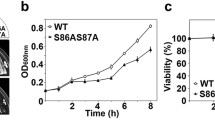Abstract.
We previously used a genetic approach to identify a new class of Schizosaccharomyces pombe genes (chromosome loss when overexpressed; clo genes) that, when present in elevated dosage, cause the loss of an otherwise stable cen1 linear minichromosome at high rates. Here we report the identities of two clo genes; one encodes histone H3.3 and the other, designated clo2, encodes a novel protein with significant homology to fission yeast Swi6p, human and Drosophila HP1 heterochromatin proteins, and other chromo domain-containing proteins. Members of this group have been shown to localize to heterochromatic DNA, including centromeres, and to play roles in chromatin formation and organization. The S. pombe Clo2 protein localizes to centromere DNA in vivo, and overexpression of clo2 leads to a dramatic increase in the rate of mitotic loss of an artificial chromosome. Clo2p is not essential for mitotic growth, however, even in cells that also lack Swi6p. Thus, fission yeast appears to utilize multiple, functionally redundant, HP1-related proteins for heterochromatin-associated activities at centromeres and perhaps elsewhere in the genome.
Similar content being viewed by others
Author information
Authors and Affiliations
Additional information
Electronic Publication
Rights and permissions
About this article
Cite this article
Halverson, D., Gutkin, G. & Clarke, L. A novel member of the Swi6p family of fission yeast chromo domain-containing proteins associates with the centromere in vivo and affects chromosome segregation. Mol Gen Genet 264, 492–505 (2000). https://doi.org/10.1007/s004380000338
Received:
Accepted:
Published:
Issue Date:
DOI: https://doi.org/10.1007/s004380000338




